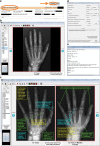Skeletal development of the hand and wrist: digital bone age companion-a suitable alternative to the Greulich and Pyle atlas for bone age assessment?
- PMID: 28343328
- PMCID: PMC5393285
- DOI: 10.1007/s00256-017-2616-7
Skeletal development of the hand and wrist: digital bone age companion-a suitable alternative to the Greulich and Pyle atlas for bone age assessment?
Abstract
Purpose: To assess reader performance and subjective workflow experience when reporting bone age studies with a digital bone age reference as compared to the Greulich and Pyle atlas (G&P). We hypothesized that pediatric radiologists would achieve equivalent results with each method while digital workflow would improve speed, experience, and reporting quality.
Materials and methods: IRB approval was obtained for this HIPAA-compliant study. Two pediatric radiologists performed research interpretations of bone age studies randomized to either the digital (Digital Bone Age Companion, Oxford University Press) or G&P method, generating reports to mimic clinical workflow. Bone age standard selection, interpretation-reporting time, and user preferences were recorded. Reports were reviewed for typographical or speech recognition errors. Comparisons of agreement were conducted by way of Fisher's exact tests. Interpretation-reporting times were analyzed on the natural logarithmic scale via a linear mixed model and transformed to the geometric mean. Subjective workflow experience was compared with an exact binomial test. Report errors were compared via a paired random permutation test.
Results: There was no difference in bone age determination between atlases (p = 0.495). The interpretation-reporting time (p < 0.001) was significantly faster with the digital method. The faculty indicated preference for the digital atlas (p < 0.001). Signed reports had fewer errors with the digital atlas (p < 0.001).
Conclusions: Bone age study interpretations performed with the digital method were similar to those performed with the Greulich and Pyle atlas. The digital atlas saved time, improved workflow experience, and reduced reporting errors relative to the Greulich and Pyle atlas when integrated into electronic workflow.
Keywords: Bone age; Children; Development; Radiography; Skeletal age; Skeletal maturity.
Conflict of interest statement
Disclosures
Cree Gaskin receives author royalties from Thieme Medical Publishers and Oxford University Press, as well as research grant funding from Carestream Health. This author did not participate in bone age study interpretation or in the statistical analysis.
Drs. Bunch, Altes, and McIlhenny and Mr. Patrie have no financial disclosures.
Ethics approval
All procedures performed in studies involving human participants were in accordance with the ethical standards of the institutional research committee and with the 1964 Helsinki Declaration and its later amendments. For this type of study formal consent is not required.
Conflict of interest/disclosure statement
The corresponding author receives author royalties from Oxford University Press and Thieme Medical Publishers. Additionally, the corresponding author has a research grant from Carestream Health. This author did not participate in bone age study interpretation or in the statistical analysis. The other authors have no financial disclosures.
Figures


References
-
- Tanner JM, Healy M, Goldstein H, Cameron N. Assessment of skeletal maturity and prediction of adult height (TW3 method) London; New York: W.B. Saunders; 2001.
MeSH terms
LinkOut - more resources
Full Text Sources
Other Literature Sources

